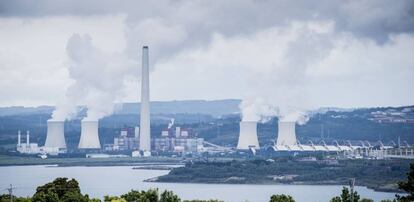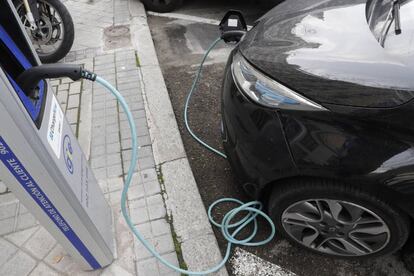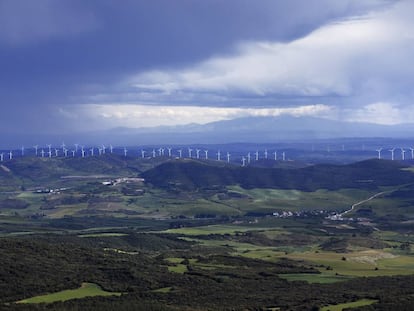Spain: time to get serious about addressing climate change
Energy transition law is in the works, but electricity and transportation emissions must be reduced

Between 1995 and 2015, the death toll from natural disasters in Spain was 1,215. Flooding, for example, killed 328 people, and heat waves caused 178 deaths, according to figures from the Directorate General for Civil Protection and Emergencies.

The UN and a wide range of scientific bodies warn that climate change not only affects average temperatures, but also increases the number and intensity of natural disasters: they are a knock-on effect like the transformation of land into desert, and land loss due to rising sea levels.
As a member of the EU and a signatory of the Paris climate agreement, Spain is aware of the need to eliminate the fossil fuels responsible for greenhouse gas emissions while maintaining economic growth. But the government’s own forecasts indicate that, far from reducing emissions, Spain is on course to increase them over the next 20 years. In 2040, the country will spill the equivalent of 353.7 million tons of carbon dioxide equivalent (CDE) into the atmosphere, which will be 18 million tons more than in 2015.
This is a unique opportunity. We have all the ingredients, we just have to see how they get cooked
Mario Rodríguez, head of Greenpeace Spain
This is why Spain needs a roadmap that will help it meet the objectives set out in Paris. The EU is committed to reducing the 1990 level of emissions by 40% by the year 2030. Now the Spanish government is drawing up a bill on climate change and energy transition that should help the country meet these goals and which, according to Prime Minister Mariano Rajoy, should be ready during his current term in office.
“This is a unique opportunity,” says Mario Rodríguez, head of Greenpeace in Spain. “We have all the ingredients, we just have to see how they get cooked.”
Curiously, Rodríguez includes US President Donald Trump’s exit from the Paris Agreement as a positive factor for the new law. “Europe is emerging now as the world climate leader and Spain needs to assume a role in this,” he says. “Climate change is on the political agenda.”
Rodríguez also believes that the fragmented state of Spanish Congress is beneficial. “Most parties have introduced proposals on energy and environmental taxation in their manifestos”, says Xavier Labandeira, director of Economics for Energy.

Environmentalists, businesspeople and energy providers all want to see a stable consensus reached among politicians, to avoid amendments being introduced with every new government. Representatives of each sector made this point at an event entitled ‘Spain, together for the climate,’ which took place in late May.
Above all, climate change policies need to be long-term, with objectives set for 2030 and 2050. The EU, for example, has pledged to reduce greenhouse gas emissions by more than 80% by 2050, which means getting almost entirely rid of fossil fuels as an energy source.
The main players
Energy is responsible for almost 80% of Spanish CO2 emissions. Within that sphere, electricity generation accounted for 26% of emissions in 2015, while transportation represented 25%. In order to reach the Paris objectives, the emissions from these sectors need to be tackled. Hence, both the Environment and Energy ministries are involved in drafting the new law before it is sent to Brussels.
As far as electricity is concerned, technological progress coupled with lower costs for renewables brings closer the prospect of clean energy production. But parties and industry representatives must still reach consensus on matters such as the role of nuclear power, a schedule for the phaseout of fossil fuels, and the role of home generation.
Meanwhile, clean transportation presents a challenge, with electric cars still representing a negligible share of vehicles on Spanish roads. Between 1990 and 2015, transportation emissions grew by 41%. If nothing is done, the government forecasts an increase of another 15% by 2030.
The exorbitant cost of ‘clean coal’
In order to justify his exit from the 2015 Paris Agreement, US President Donald Trump cited the need to support the national coal industry with a promise to back “clean coal”.
But what exactly is clean coal? The term refers to a technique that allows the CO2 emitted by coal-fired thermal power stations to be trapped and stored. After years of research, this expensive and unpopular method does not cover even 1% of the world's electricity production.
Spain is also involved in a debate over the future of coal-generated electricity, which is responsible for 15% of all CO2 emissions in the country. But Repsol recently suggested that the cost of storing a ton of CO2 would be between €60 and €80. Spain's 15 active coal-fired power stations emitted 52,09 million tons of carbon dioxide in 2015. If they stored this, it would cost between €3.1 billion and €4.2 billion, which would send the price of electricity through the roof at a time when renewables are increasingly cheap and competitive.
As the most contaminating way of generating electricity, coal is currently demonized in Europe. However, the Spanish Energy Ministry opposes the closure of energy provider Endesa’s power stations in Compostilla and Teruel, which are fired by national coal, by 2020. And a number of politicians, particularly in Castilla y León and Aragon, are lobbying for them to remain open.
English version by Heather Galloway.
Tu suscripción se está usando en otro dispositivo
¿Quieres añadir otro usuario a tu suscripción?
Si continúas leyendo en este dispositivo, no se podrá leer en el otro.
FlechaTu suscripción se está usando en otro dispositivo y solo puedes acceder a EL PAÍS desde un dispositivo a la vez.
Si quieres compartir tu cuenta, cambia tu suscripción a la modalidad Premium, así podrás añadir otro usuario. Cada uno accederá con su propia cuenta de email, lo que os permitirá personalizar vuestra experiencia en EL PAÍS.
¿Tienes una suscripción de empresa? Accede aquí para contratar más cuentas.
En el caso de no saber quién está usando tu cuenta, te recomendamos cambiar tu contraseña aquí.
Si decides continuar compartiendo tu cuenta, este mensaje se mostrará en tu dispositivo y en el de la otra persona que está usando tu cuenta de forma indefinida, afectando a tu experiencia de lectura. Puedes consultar aquí los términos y condiciones de la suscripción digital.
More information
Archived In
Últimas noticias
From Andorra to Gibraltar, a black market for Ozempic exploits its success: ‘They’re the most sought-after products in the world’
The brief rise and retreat of Generation Z in Mexico
From safe-haven investment to geostrategic weapon: Who owns the most gold and where are the bars kept?
Todd Green, head of the company that created ‘Candy Crush’: ‘Success for us is that players want to play for years’
Most viewed
- Why we lost the habit of sleeping in two segments and how that changed our sense of time
- Charles Dubouloz, mountaineering star, retires at 36 with a farewell tour inspired by Walter Bonatti
- Venezuela faces its most tense Christmas yet
- CBS in crisis after pulling a report on Trump’s deportations to El Salvador (which later leaked online)
- Bukele clan fumes over investigation exposing their new wealth









































